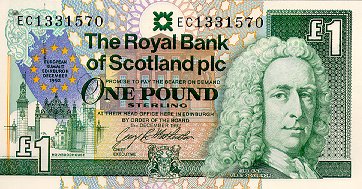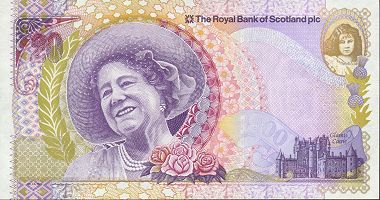|
The United Kingdom is one of the few countries in the world where the issue of bank notes is not restricted to the
Government and/or its Central Bank. In Scotland,
there is a proud tradition of producing bank notes since 1695.
Rampant Scotland Directory
Current
Royal Bank Notes
The Royal Bank of Scotland, founded in 1825, currently issues bank notes to the value of 1, 5, 10, 20
and 100 pounds. It is the only UK bank still with the low denomination one pound note in circulation - it has been largely
been superseded by the one pound coin issued by the Mint.

Current Royal Bank of Scotland
One Pound Note (Front)
All the Royal Bank notes incorporate a portrait of Lord Ilay, the first Governor of the bank together
with the bank's logo and coat of arms. The semi-circle of "stars" is a representation of the magnificent ceiling in the bank's
head office in St Andrew Square, Edinburgh.

Current Royal Bank of Scotland
Five Pound Note (Reverse)
The current series of Royal bank notes illustrate Scottish castles on the reverese of the notes.
This one is Culzean Castle. Situated on a cliff on the Ayrshire coast some eleven miles south of Ayr, it was formerly the
seat of the Marquis of Ailsa. It is now one of the properties of the National Trust for Scotland and a well-known tourist
attraction. The Eisenhower Suite at Culzean Castle was presented to Dwight D Eisenhower in recognition of his role as supreme
Commander of the Allied Forces in World War II

Current Royal Bank of Scotland
Ten Pound Note (Front)
As can be seen, the design of the front of the Royal bank notes is identical. apart from the change
of colour. The reverse of the ten pound note shows Glamis Castle which was reputedly the scene of Macbeth's murder of King
Malcolm II in 1031. It is the seat of the Earl of Strathmore, whose ancestors were Deputy Governors of the Royal Bank of Scotland
in its early days. Her Majesty the Queen Mother spent her early years there and Princess Margaret was born in the castle,
the last member of the Royal Family to be born in Scotland.

Current Royal Bank of Scotland
One Hundred Pound Note (Reverse)
This is the highest denomination Royal Bank note in circulation. It illustrates Balmoral
Castle, the royal residence in Deeside. Balmoral was built in 1853 to replace an existing building. It was a great favourite
of Queen Victoria and has provided successive Royal Families with a suitable location in which to enjoy periods of rest, relaxation
and, above all, privacy.

Having issued the very first
commemorative bank note in the United Kingdom, The Royal Bank of Scotland has continued to issue such notes in recent years
- all in the unique one pound value.
Royal Bank of Scotland One Pound
Note (Front)
The first UK commemorative bank note, the standard Royal Bank pound note had a panel added to the standard
design incorporating the EU stars and the gates of Holyrood Palace (where the European Summit Conference of heads of state
was held in December 1992.

Royal Bank of Scotland Pound
Note issued in 1994 to mark the 100th Anniversary of the death of Robert Louis Stevenson (Reverse)
Robert Louis Stevenson,
born in Edinburgh in 1850, was the author of such classics as "Treasure Island," "Kidnapped" and "Dr Jekyll and Mr Hyde".
The front of this note has a quill pen and a copy of Stevenson's signature. The reverse, illustrated above, incorporates not
only Stevenson's portrait but scenes from some of his books - and his house in Wester Samoa where he died in 1894.

Royal Bank of Scotland Pound
Note to mark the 150th Anniversary of the Birth of Alexander Graham Bell (Reverse)
On 3 March 1997, The Royal Bank of Scotland
issued 2 million commemorative banknotes to mark the 150th anniversary of the birth of one of Edinburgh's most famous sons.
Alexander Graham Bell was born in Edinburgh in 1847 at 14 South Charlotte Street in the west end of Princes Street in the
elegant Georgian New Town. Like his father, he became a teacher of the deaf but after working in schools in the north of Scotland
and Edinburgh he emigrated at the age of 23 to Canada and on to Boston in the hope of escaping tuberculosis (which had claimed
both his brothers). It was there in 1875 that his studies in the mechanics of sound led him to produce the world's first telephone,
excitedly calling his assistant Mr Watson with the classic words "Come here Mr Watson, I want to see you." Thus began the
development which allows you to read these words today.
It was the telephone which gave
him his world-wide fame, although his fertile mind was applied to many other fields, some of which are acknowledged in the
special design of this banknote. The reverse of the note (illustrated) is a complete redesign, replacing the usual engraving
of Edinburgh Castle, with a montage tribute to Bell. The images include users of the telephone over the ages, a wave signal
for "telephone", a schematic drawing of a telephone receiver and Bell's initialled signature.
They also acknowledge Bell's
other interests - the geese which he studied to understand flight (he worked with the Wright brothers), the sheep which helped
him to understand genetics and the geometric shapes which he used to develop engineering structures. His work as a teacher
of the deaf is acknowledged by representations of sign language and the phonetic alphabet developed by his father. Bell is
also shown in old age with his wife - he and his father both married young deaf pupils.
It was a wonderful coincidence
that in the week that this note was issued the story broke of the cloning of Dolly the sheep at the Roslin Institute near
Edinburgh.

Scottish Parliament Commemorative
Bank Note (Front)
All the Royal Bank notes incorporate a portrait of Lord Ilay, the first Governor of the bank together
with the bank's logo and coat of arms. The semi-circle of "stars" is a representation of the magnificent ceiling in the bank's
head office in St Andrew Square, Edinburgh. The special elements denoting the commemorative theme include (in the bottom left
hand corner) a St Andrew's flag set below a silhouette of the Church of Scotland Assembly Hall, the temporary home of the
Parliament. The serial numbers of the notes are all in the "SP" range (for "Scottish Parliament") and the text with these
words is in a font used by the architect in his drawings for the new building. The date of issue of the note is 12 May, 1999,
the day the new Parliament sat for the first time.

Scottish Parliament Commemorative
Bank Note (Reverse)
The reverse of the commemorative note shows a vignette of the exterior of the temporary Parliament
Buildng and an abstract image based on the floorplan of the new building planned for Holyroodhouse. Some of the text on the
note is in the style used by the architect of the new building, Enric Miralles.

Commemorative Bank Note for 100th
Birthday of
Queen Elizabeth the Queen Mother (Front)
Queen Elizabeth the Queen Mother had strong Scottish connections.
Before her marriage, she was Lady Elizabeth Bowes Lyon, daughter of the Earl of Strathmore and Kinghorne, and spent much of
her childhood at Glamis Castle in Angus. So it was only natural that the Royal Bank of Scotland should issue a bank note to
commemorate her achievement of reaching her 100th birthday on 4 August 2000.
As in most of the Royal Bank commemorative
notes, the design on the front is not greatly different from the normal notes. The portrait of Lord Ilay, the first governor
of the Royal Bank of Scotland (in 1727) is prominent and the "stars" in the ornate ceiling of the bank's Head Office in St
Andrew Square are a feature near the top of the note. In the case of the Queen Mother Commemorative notes, however, it was
decided to use the higher value of £20 instead of the £1 or £5 used on other occasions and the notes also bear a gold crown.
. All the serial numbers begin with "QETQM" and run from 00000001 to 2000000 for the two million notes issued and for the
first time the signature of the new Group Chief Executive, Fred Goodwin appear on a Royal Bank note. Uniquely in Scottish
banking, he had previously signed Clydesdale Bank notes when he was Chief Executive there.

Commemorative Bank Note for 100th
Birthday of
Queen Elizabeth the Queen Mother (Reverse)
The reverse of the commemorative note shows a hand engraved
portrait of Queen Elizabeth the Queen Mother and the overall design is "art nouveau" reflecting the style in vogue in 1900.
There are a number of images associated with royalty and Scotland - the laurel to the left of the portrait, gold inks, a thistle
and other floral images associated with Queen Elizabeth the Queen Mother, and there are hints of tartan in some of the patterns.
On the top right of the note is a cameo portrait of Lady Elizabeth Bowes Lyon at the age of six. Under this is an engraving
of Glamis Castle, her childhood home.
A SCOTTISH RECIPE
COCK-A-LEEKIE SOUP
1 x 1-1.5
Kg (2-3lb) chicken
1 onion, cut into quarters
400-800g (1-2lb) leeks, cut into inch long (2-3cm) pieces,
white and
green parts to be kept separate
Chicken stock from boiling the chicken
1 bay leafand a bunch of parsley
6-12 prunes,
soaked overnight
salt and pepper
Method
Put the chicken in
a large pot and nearly cover with water,
add the herbs and salt and slowly bring to the boil.
Skim, cover and simmer
until tender, for approximately
2 hours. Remove the bird, and allow to cool slightly.
Meanwhile add the green part
of the leeks to the stock
and add the prunes (cut ito quarters) and continue to
simmer. Cut the meat from the chicken
into smallish
pieces and return them to the soup, with the white
part of the leeks. Simmer for a further 10 minutes.
Check
the seasoning and serve.
Cock-a-Leekie Soup is better the next day,
so if you have time, try and prepare it in advance
and
reheat it when needed.
Flower of Scotland Lyrics
(Written by Roy Williamson of "The Corries")
Although "Flower of Scotland" is not a traditional
song, it has been adopted as Scotland's de facto national anthem, along with "Scotland the Brave"
O Flower of Scotland,
When
will we see
Your like again,
That fought and died for,
Your wee bit Hill and Glen,
And stood against him,
Proud
Edward's Army,
And sent him homeward,
Tae think again.
The Hills are bare now,
And
Autumn leaves
lie thick and still,
O'er land that is lost now,
Which those so dearly held,
That stood against
him,
Proud Edward's Army,
And sent him homeward,
Tae think again.
Those days are past now,
And
in the past
they must remain,
But we can still rise now,
And be the nation again,
That stood against him,
Proud
Edward's Army,
And sent him homeward,
Tae think again.
0 Flower of Scotland,
When will
we see
your like again,
That fought and died for,
Your wee bit Hill and Glen,
And stood against him,
Proud
Edward's Army,
And sent him homeward,
Tae think again.
THE ABOVE IS THE MUSIC PLAYING
ON MY PAGE HERE:)
MY HEARTFELT THANKS TO THE FOLLOWING
WEBSITE FOR THE INFORMATION FOR FREE USED ON MY PAGE
|

